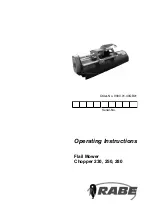
page A – 12
FM-531HD / May 2013
A P P E N D I C E S
Interpreting Common Audio Processing Terms
Background
When tasked with adjusting audio processing one is often faced with myriad meanings
for the same sound descriptors. When the program director comments that it needs more
“thump,” what does he really mean? If he says that the audio is too “crunchy,” what is
he hearing? Or if he says that the competition is nice and “bright” and they have some
nice “rumble,” what exactly is that? Or what if he wants more bass and you add some
bottom end but now he says “we sound too muddy”? How do we untangle this and get to
the bottom of what the PD really means?
Lots of “audio” terms regarding audio processing have been invented and bandied about
over the years. Ever since radio stations started employing circuits instead of humans to
control the modulation of transmitters we’ve tried to come up with words to describe the
effects of processing and what we hear. Many of these terms were born out of simply try-
ing to put into words the positive and negative artifacts of early compressors and limiters
(thump, muddy, honk, tubby). Still others were born later when EQ and different forms
of “enhancers” were added to audio chains and audio processors to exaggerate certain
parts of the frequency spectrum (rumble, punch for bass; bright, airy, open to describe
presence and the high end).
The language
of audio processing more often than not needs the benefit of an interpreter.
Some oft-used terms can easily have multiple meanings and be confused with others.
Some of the terms we use simply don’t describe very well what is actually happening to
the audio. For instance, one listener might feel the audio is “muddy” while another one
still might describe it as “warm.” Which one is right? For starters, “muddy” is not usu-
ally used in a positive sense, while warm, on the other hand, often means the sound has
a pleasing low end. See the confusion here?
The terms themselves, the ones that we use to describe sound, can be confusing enough.
The real question then becomes, what do these terms really mean, and which knob do
we turn if we want to change the sound? In fact, here is a very common challenge: if the
audio is too “muddy,” do you turn up the high end, or do you reduce the low end? Which
control is the right one if you wanted to bring up some low end “rumble” or “sub bass”?
And here’s another one; if the audio is “tinny,” is the problem that there’s too much energy
up around 8,000Hz or is the problem actually further down in the spectrum?
We’ve created a graphic to try to bring some understanding to the more common terms
we broadcasters use to describe sound and where these sounds actually reside in the audio
frequency spectrum. While creating an exhaustive list isn’t impossible, it is well beyond
the scope of what we’re trying to accomplish here. What we’ve done instead is compile
the terms we most commonly hear customers use, and then lay them out in graphic form
to help visualize what sounds live in what part of the audio spectrum we hear.
Included in the chart below are the frequency ranges of the most common instruments
heard in compilations played on the radio. The idea here is to marry musical instruments
and their sounds with the terms we all use. One good example might be the term “Honk,”
which coincidentally happens to be right in the middle of the frequency range created by
saxophones. The goal here is simple; offer a better understanding of how to adjust an au-
dio processor so that the “thump” you want will be the “thump” you get and not “tubby.”
Please note that some of the controls mentioned on the following pages may not be
available on the FM-531HD. The discussion is generic to a wide variety of Wheatstone
processor models.
Summary of Contents for FM-531 HD
Page 2: ...Technical Manual Wheatstone Corporation May 2013 FM HD Digital Audio Processor FM 531hd...
Page 122: ...page A 2 FM 531HD May 2013 A P P E N D I C E S Appendix A General Specifications A 3 Contents...
Page 128: ...page A 8 FM 531HD May 2013 A P P E N D I C E S Appendix B FM 531HD GPI Interface A 9 Contents...











































